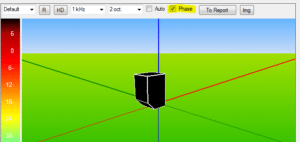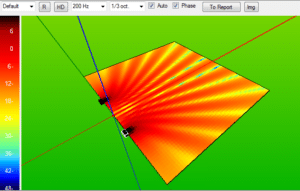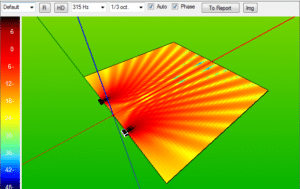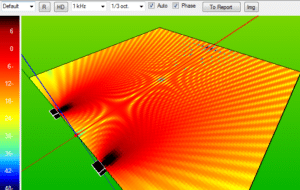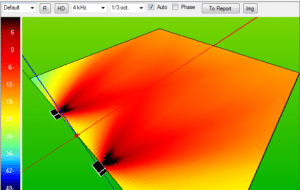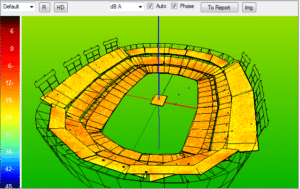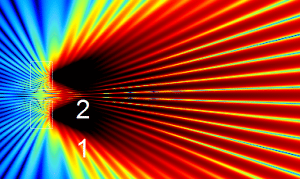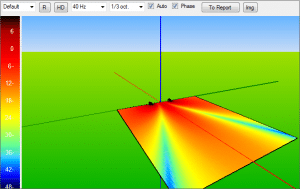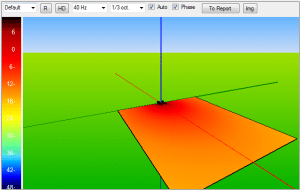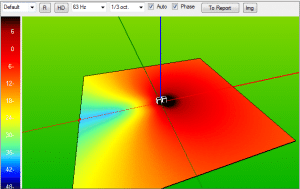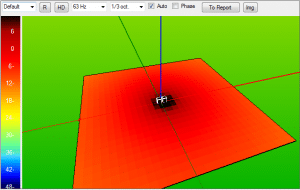Phase or No Phase
(on sound simulations)
As any self-respecting audio engineer knows, phase is one of the key parameters to consider when talking of sound reinforcement. In sound reinforcement, the sound sources tend to couple, in different ways. We have what is called acoustical summation, which is a very strange kind of summation. In acoustical summation, sometimes 100 dB + 100 dB = 106 dB. But sometimes 100 dB+ 100 dB = 103 dB. Or maybe more confusing, sometimes 100 dB+ 100 dB = 0 dB. Why? As always in audio, the answer is “it depends”. It depends on frequency, it depends on distance and level between sources. And to complicate things, even more, it will vary depending on where you are in the audience. This article is not intended to dig into the depths of phase, rather we want to present a few simple examples to show when is it good to use the phase option in our simulation program Direct, and when it is ok to leave the phase turned off.
Most simulation programs out there will simply not give you the opportunity of doing phase calculations. In Direct we have clearly identified the checkbox on the main 3d window:
Why doesn’t other software give you the opportunity of doing phase-calculations? I think that it`s because when speakers interact, the variance in the level that occurs may not look so nice in the “rendering”. But in reality, phase always has importance in sound propagation and summation. In a perfect world, each person in the audience gets sound from the minimum quantity of sources. That way, the summation the person receives is less affected by the interaction of different boxes. That`s one of the reasons why Danley puts so much emphasis on controlling directivity with big horns. Put the sound where it belongs with as few boxes as possible! Of course, there exist other approaches that tend to put a high number of boxes on each listener… line arrays!
Some people are phase fanatics! “If you don`t use phase you are not a real professional ”. Some people never look at the phase at all. Some software won’t let you turn phase off, other software won’t let you turn it on!
Let’s look at some simple examples where the phase is very important to simulate, and others where it’s not so important, in order to understand why it’s important to have the option of choosing to look at phase summation or not.
The first place where I think phase summation is not important to show is a typical live concert with an L – R deployment. A couple of loudspeakers, separated by one stage, big or small, will always have chaotic phase and acoustical summation of all kinds. Let`s look at a few examples and keep in mind that I`m talking here about mid-high frequencies.
200 hz and 315 hz
1khz and 5khz
All those yellow lines you see on the 200 and 315 plots also exist at 1khz and 5khz, it’s just that the lines are so many and so thin we can`t see them well. These lines of negative acoustical summation will vary depending on frequency and location. The most important thing to understand is that all that bunch of sums and cancellations exists in EVERY audio system of this kind. No matter the processing, no matter the magic 50 channel dsp per box, this is what you have had on every single concert you have attended. Here we are showing 2 boxes, 1 per side, imagine what it would look like with 30 per side!
So as this is real life, this is a case where I would definitively recommend not to use phase. Look at a comparison between phase summation and no phase summation on the given example, with a frequency of 4 khz.
To me, they both say the same thing. They show us the coverage. Coverage should be the main goal of any designer working on an L – R system. Plus, although we engineers know the effect of phase, the simulation with phase off will look much more attractive to a client!
I have a friend that likes to display phase summation at 16khz on a system like this. That`s pointless in my way of thinking. I`m a practical designer!
Another kind of project where I don’t think it is necessary to display the phase summation is a stadium with a distributed system. Interactions will occur, you can be sure, but always try to ensure that the sound at any seat comes from 1 speaker. Control dispersion, and you will be able to accomplish your goal. In these systems, intelligibility is very important, especially when the system is used for human safety. Intelligibility improves when the number of sources arriving at any seat is low.
A Stadium, dBA plotted.
That “noise” on the orange/yellow variation is phase interaction
Just for fun, look at your home theatre HI-FI summation at just 5 kHz. It doesn’t matter if the brand is Genelec or Danley.
This is the summation at mid-high freqs
3 feet separation between L-R
(not counting reflections 🙁
Now on the other hand, when do I personally think the phase button should be turned on? When looking at Low frequencies. This is because, due to the long wavelengths involved, the geometrical places where the destructive summation occurs are very large.
This is a L – R configuration of subs – stage 10m width
The drop in level may be too much in some significant areas
This can only be seen with phase turned on
Same subs, but placed together.
A much better solution!
Directional sub-arrays are here to stay. To properly design and evaluate direction sub arrays you MUST use phase summation.
Low freq cardioid system. Phase on is a must.
I hope this article was fun for you. The main thing is to have the option to turn phase summation on and off and then choose for yourself what will you use. I would recommend always check a little bit with phase on, most of all in low frequencies.
Sebastian Rivas
Danley Sound Labs
Experience Danley in Person
Find a local distributor and schedule a live demo with one of our many experienced distributors and sound consultants.

